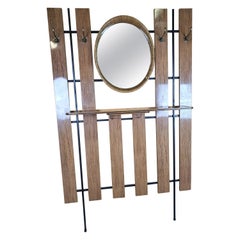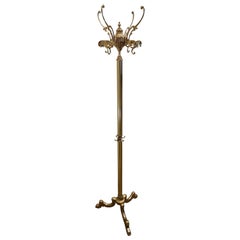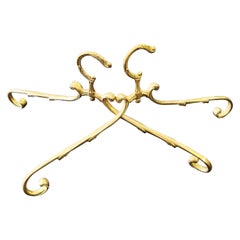PVC Wardrobes and Armoires
to
1
Height
to
Width
to
Depth
to
1
1
1
1
1
1
708
1,746
720
373
357
1
1
1
Material: PVC
Wall Hanger with Mirror from 50s
Located in Premariacco, IT
Directly from the 1950s, a particular wall hanger with four brass hangers and a large central mirror.
With a modern and functional design, it can be placed in all entrances to houses or premises.
The panels are covered in plastic/PVC, supported by a rear iron structure.
The brass hangers were installed new during the polishing of the hanger.
Category
1950s Mid-Century Modern Vintage PVC Wardrobes and Armoires
Materials
Brass, Steel
$825 Sale Price
20% Off
Related Items
1980s Italian Midcentury Hollywood Regency Neoclassical Brass Floor Coat Hanger
Located in Carimate, Como
Beautiful and stylish vintage 1980s Italian brass floor coat hanger. A great piece that perfectly adds to every home decor the typical glitz, g...
Category
Mid-20th Century Italian Hollywood Regency PVC Wardrobes and Armoires
Materials
Brass
$1,426
H 68.9 in W 17.72 in D 17.72 in
1980s Italian Hollywood Regency Neoclassical Solid Brass Coat Hangers
Located in Carimate, Como
1980s Italian Hollywood Regency neoclassical solid brass coat hangers, large stock available coming from one of Italy's main brass producers of late 20th century, the brass is in exc...
Category
Late 20th Century Italian Hollywood Regency PVC Wardrobes and Armoires
Materials
Brass
$332 / set
H 7.88 in W 16.93 in D 0.79 in
Antique Oak Side by Side Armoire with Mirror
Located in Freehold, NJ
This antique side by side features four drawers with carved wood pull, large cabinet with expanding rack for hanging clothes, adjustable mirror, and wheeled feet.
Dimensions: 40w 19.5d 64h
Condition notes: Original finish is in good condition. Antique wheels...
Category
Early 20th Century American American Craftsman PVC Wardrobes and Armoires
Materials
Mirror, Oak
1950s Carved Wooden Cabinet from Congo
Located in Antwerp, BE
One of a kind ethnic wooden cabinet from the 1950s depicting rural life in Zaïre (now the Congo). Bas-relief technique on solid wood. Great original condition. The front legs of this...
Category
Mid-20th Century Congolese Mid-Century Modern PVC Wardrobes and Armoires
Materials
Wood
1970s Golden Brass Garment Rack, Clothing Stand Rail, Dress Hanger, Italy
Located in Carimate, Como
Vintage 1970s Italian stylish and polished shiny brass hanger stand, with Classic carved column and decorated top finals, standing on 4 brass covered wheels. A great piece that perfe...
Category
Mid-20th Century Italian Hollywood Regency PVC Wardrobes and Armoires
Materials
Brass
$2,686 / item
H 74.02 in W 53.94 in D 17.33 in
Large Italian Mirrored Wardrobe in Walnut with Mirror Panels
Located in Waalwijk, NL
Wardrobe, walnut burl and veneer, mirrored glass, glass, brass, Italy, 1950s
A beautiful and luxurious Italian wardrobe or very large cabinet. With its seven doors this wardrobe has...
Category
1950s Italian Mid-Century Modern Vintage PVC Wardrobes and Armoires
Materials
Brass
Art Deco wrouth iron wardrobe with mirror and light
Located in Schöfflisdorf, CH
Art Deco wroth iron wardrobe with mirror
Category
1930s French Art Deco Vintage PVC Wardrobes and Armoires
Materials
Wrought Iron
Mid Century Teak Wardrobe from Avalon With Top Box, 1970s
Located in South Shields, GB
A freestanding double door taller than usual teak wardrobe from Avalon- circa 1970s
Fitted out with a clothes rail and shelving
There is also additional storage to the top box compa...
Category
Mid-20th Century British Mid-Century Modern PVC Wardrobes and Armoires
Materials
Teak
pair of GIO PONTI laminate wall cupboard doors with mirrors Hotel PdP Rome, 1964
By Gio Ponti
Located in Rome, IT
pair of GIO PONTI wall cupboard doors, wardrobe, from the original furniture of the Hotel Parco dei Principi in Rome, 1964
ash, formica-laminate- mirror
green-blu formica-laminate on the cover and white formica on the verso
manufactured by dassi Lissone
Measures: height:175cm, 135 x 3 cm
very good condition
Provenance: this item coming directly from the original furniture of the Hotel PdP
copy of original invoice of the Parco dei principi Hotel is available on request
Literature:
Gio Ponti l’arte si innamora dell’industria-Ugo La Pietra pp 365,367
-Ugo La Pietra, Gio Ponti, New York, 1996, p. 373
-Fabrizio Mautone- Gio Ponti La committenza Fernandes, Electa Napoli 2009,pg 153
Exhibitions ( a similar example):
-CENTOVENTI GIO’ PONTI designer...
Category
1960s Italian Mid-Century Modern Vintage PVC Wardrobes and Armoires
Materials
Mirror, Formica, Ash
$3,887 / set
H 68.9 in W 53.15 in D 1.19 in
Exquisite Italian Wardrobe with Mirrored Doors in Walnut Burl
Located in Waalwijk, NL
Large Italian wardrobe, walnut burl, glass, brass, mahogany, maple, Italy, 1950s
This exclusive Italian wardrobe has a remarkable size; with its width of over 10ft, this cabinet offers plenty of storage space. Four doors hold a mirrored surface lined with a decorative wooden frame, the two outer doors have a luxurious wooden surface. Three double doors structure the access to the storage space which is a combination of drawers and cloths racks...
Category
1950s Italian Mid-Century Modern Vintage PVC Wardrobes and Armoires
Materials
Brass
$9,700
H 75.79 in W 122.84 in D 24.41 in
Important Renaissance Cabinet from Lyon 'France' with a Decor of Perspectives
Located in Saint-Ouen, FR
As soon as 1540 France's second Renaissance is in the making, intimately linked to the rediscovery of the Antique world. The development of the printing and engraving industry allows the spread of artworks and models in many cities and countries. The Italian influence can be perceived in every artistic field. While the French king entrust the most talented Italian artists with major projects such as Il Rosso or Primaticcio in Fontainebleau, French artists also travel to Italy to form themselves to this new style. In Italy they get acquainted with the work of Leo Battista Alberti the first to theorize perspective (De Pictura, 1435-36) and architecture (De re oedificatoria, 1541). Those two publications would have a revolutionary impact on arts.
Furniture is marked by the work of the most famous Italian architects of the time as well as French architects. Indeed Philibert de l'Orme competes with Alberti and by the end of his life publishes several treaties including one devoted to a theory of architecture (1567). Unfortunately he would not live to complete the second volume. In this treaty he expresses his interest for mathematical norms applied to architecture, copied from the Antique. His journeys in Italy allowed him to accumulate the most sophisticated references. Jean Bullant, another architect of great talent also theorizes his practice. He establishes rules characterizing Greco-Roman art staying faithful to Vitruvius.
Following this new inspiration the structure of furniture evolves. From then on appear columns, capitals, cornices, friezes and architraves. The ornamentation uses this inspiration as well with egg-and-dart, palm leaf and rose adorning the most beautiful pieces.
In Lyon, crossroad where meet merchants from everywhere those new experiments are welcomed. Lyon florishing printing industry allows the spreading of models and treaties essential to the artist's work. Thus the first publication of Vitruvius' De Architectura in France would be printed in Lyon in 1532.
Artists from Lyon rediscover and familiarize themselves with the Antique knowledge very early. They adopt those new ideas and use them in their own creations. Lyon cabinet-makers re interpret Antique architecture and Italian Renaissance palaces to give their pieces a pure and harmonious architectural structure. Grooved pilasters are particularly favored. They are topped by capitals of diverse orders always respecting the sequencing with simpler ones for the lower levels and the richest ones on the higher levels. As for the ornamentation, one of the great distinctiveness of Lyon workshops remains the architectural perspective illusions, drawing inspiration from Tuscany.
True masterpiece of the Second French Renaissance this important cabinet illustrates Lyon workshops' taste for fine Italian architecture inspired by Antiquity. An architectural perspective of great quality is treated in symmetry on each panel.
This two-bodied cabinet without recess stands on four rectangular feet. The base comprises a molding, a palm leaf frieze and is bordered by a braid.
The lower body is divided by three grooved pilasters with Tuscan capitals framing two door-leaves. The two panels are encircled by a moudled frame with palm leaves. They are finely carved with a decor of fantasized architecture depicting an Italian Renaissance palace erected symmetrically on each side of a grooved pilaster. On the ground floor a door opens through a stilted arch while the stories are opened with mullioned windows, dormers and occuli. Two large pegged-boss cladded pillars support the entablature enriched by a palm leaf frieze upon which stands an arch whose coffered intrados is centred by a rose. Behind this arch a pyramid appears, standing in front of a second facade with a window topped by a broken curvilinear pediment under a cul-de-four with a shell.
The checker flooring gives depth to the low-reliefs creating vanishing points structuring the panels and guiding the eye of the observer.
A thin laurel braid highlights the belt of the cabinet where are located two drawers. Their facades are adorned by palm leaves in hoops.
The upper body is encircled with palm leaves. The same ternary division as in the lower body appears. However, the pilasters are topped by Ionic capitals with volutes and egg-and-dart. The door-leaves are framed with flowers. On the panels the artist has designed another architectural decor. On the foreground open two arches on top of grooved pilasters with rectangular capitals adorned with palm leaves. The arches are enriched with braids and the coffered intrados bears a decor of roses. The spandrels also bear a flower decor. In the background another arcature hosts a fluted grooved column topped with double basket acanthus capital, characteristic of Corinthian order. The triangular pediment is interrupted by a choux bourguignon.
A large cornice crowns the cabinet. It stands on pilasters and forms an entablature comprising a palm leaf frieze and an egg-and-dart, triglyph and palm leaf cornice.
The cabinet's sides have also been carefully considered. The lower body's panels are enriched with an arch rising above a broken pediment portico hosting a twisted column. Flowers garnish the spandrels. An architectural facade completes the decor. The upper body's panels present two arches supported by a facade opened with dormers and mullioned windows as well as cartouches (one bears the inscription 1580 dating the cabinet) suggesting the interior of an Italian Renaissance palace, confirmed by the chandeliers. The flooring leads our gaze to a second arch with a broken curvilinear pediment where stands a flower vase. This arch opens onto a perspective of another facade along a road.
Inside the cabinet, on the lower body door-leaves appear two designs. On the right door is depicted a Crucifixion. Saint Mary and Saint John flank the Christ on the cross. In the bottom part is inscribed « Dure uiator abis nihil haec spectacula curas / Pendenti cum sis unica cura Deo. / Tota suo moriente dolet natura Magistro. / Nil qui solus eras caussa dolenda doles. ». The signature [Christoff Swartz Monachiensis pinx[it] / Ioa[nnes] Sadeler sculp[it]] tells us it was made by Johan Sadeler I (1550-1600) after Christoph Schwartz (1548-1592). This engraving belongs to an ensemble depicting the Passion of Christ Johan Sadeler executed in 1589 after an altar piece painted by Christoph Schwartz for the private chapel of Renée of Loraine, wife of Duke William V of Bavaria. This altar piece made of nine copper panels has been destroyed during the 19th century. The Crucifixion panel once in the centre of the altar piece is the only one that survived and is today kept in Munich's Alte Pinakothek.
On the left door appears Saint Francis receiving the stigmata. The inscription says : « Signastidomine Servum Tuum. Franciscum. Signis Redemptionis Nostrae ».
This Renaissance cabinet with an architectural decor appearing as much in the structure faithful to Antique rules...
Category
16th Century European Renaissance Antique PVC Wardrobes and Armoires
Materials
Walnut
$178,314
H 87.41 in W 74.81 in D 27.17 in
Carl Auböck II, Clothes Hangers, Austria, c. 1960
Located in Philadelphia, PA
Carl Auböck II, Austria
(7) "rare" Walnut Clothes Hangers, circa 1960
in original condition - unmarked
normal signs of use - scratches on the opposite of the brass hanger
Category
1960s Austrian Mid-Century Modern Vintage PVC Wardrobes and Armoires
Materials
Brass


